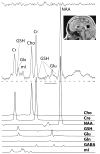LOWER POSTERIOR CINGULATE CORTEX GLUTATHIONE LEVELS IN OBSESSIVE-COMPULSIVE DISORDER
- PMID: 26949749
- PMCID: PMC4774044
- DOI: 10.1016/j.bpsc.2015.12.003
LOWER POSTERIOR CINGULATE CORTEX GLUTATHIONE LEVELS IN OBSESSIVE-COMPULSIVE DISORDER
Abstract
Background: Several lines of evidence support the hypothesis that lower cerebral levels of glutathione (GSH), associated with increased oxidative stress, may contribute to obsessive-compulsive disorder (OCD). However, no studies to date have investigated brain GSH levels in individuals with OCD.
Methods: Twenty-nine individuals with OCD and 25 age-, sex-, and race-matched comparison individuals without OCD underwent single voxel 2D J-resolved proton magnetic resonance spectroscopy (MRS) to examine GSH levels in the posterior cingulate cortex (PCC). MRS data were analyzed using LCModel and a simulated basis set. Group metabolite differences referenced to total creatine (Cr), as well as relationships between metabolite ratios and symptom severity as measured by the Yale-Brown Obsessive-Compulsive Scale (Y-BOCS), were analyzed using linear regression with adjustment for age, sex, and race.
Results: One OCD participant failed to produce usable PCC MRS data. We found significantly lower PCC GSH/Cr in OCD participants compared with non-OCD participants (β = -0.027 [95% CI: -0.049 to -5.9 × 10-3]; P = 0.014). PCC GSH/Cr was not significantly associated with total Y-BOCS score in the OCD group (β = 5.7 × 10-4 [95% CI: -4.8 × 10-3 to 5.9 × 10-3]; P = 0.83).
Conclusions: Lower PCC GSH/Cr may be indicative of increased oxidative stress secondary to hypermetabolism in this brain region in OCD. Future MRS studies are warranted to investigate GSH levels in other brain regions that comprise the cortico-striato-thalamo-cortical circuit thought to be abnormal in OCD.
Keywords: MRS; OCD; glutathione; obsessive-compulsive disorder; oxidative stress; posterior cingulate cortex.
Figures


References
-
- American Psychiatric Association. Diagnostic and Statistical Manual of Mental Disorders. 5. Washington DC: American Psychiatric Publishing; 2013.
-
- Jenike MA. Clinical practice. Obsessive-compulsive disorder. N Engl J Med. 2004;350(3):259–65. - PubMed
-
- Wu G, Fang YZ, Yang S, Lupton JR, Turner ND. Glutathione metabolism and its implications for health. J Nutr. 2004;134(3):489–92. - PubMed
-
- Aoyama K, Suh SW, Hamby AM, Liu J, Chan WY, Chen Y, et al. Neuronal glutathione deficiency and age-dependent neurodegeneration in the EAAC1 deficient mouse. Nat Neurosci. 2006;9(1):119–26. - PubMed
Grants and funding
LinkOut - more resources
Full Text Sources
Other Literature Sources
